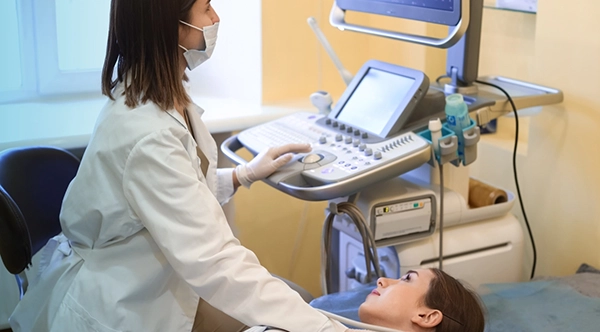Build Your Cardiovascular Technologist Pipeline: The ROI of a CVT Training Program

Key Insights:
- Cardiovascular technology demand is expected to increase, adding even more strain to cardiac care workforce shortages.
- Healthcare organizations can prepare for this demand by offering employees access to a cardiovascular technologist (CVT) training program. Upskilling medical assistants to perform CVT duties is a scalable solution.
- Nasium Training offers a tailored Cardiovascular Technology training program, enabling organizations to address their specific challenges, needs, and goals.
Now Is the Time to Prepare the Next Generation of Heart Health Professionals
Roughly every 34 seconds, someone in the U.S. dies from cardiovascular disease (CVD).1 Here’s the good news: early diagnosis can help lower the risk of death.2 Many procedures used to aid in CVD diagnosis are performed by cardiovascular technologists, making these healthcare professionals critical members of a patient’s cardiac care team.
Cardiovascular Technologist vs. Cardiovascular Technician: Understanding the Difference
Both cardiovascular technologists and cardiovascular technicians can perform noninvasive cardiac procedures. A cardiovascular technologist is also trained in invasive procedures, such as cardiac catheterization. Thus, these professionals are sometimes referred to as cardiovascular invasive specialists or cardiac catheterization technologists.3
Healthcare organizations can raise the bar in patient care by ensuring their cardiovascular technologists or CVTs are properly trained. Choosing a tailored cardiovascular technology training program provides another advantage: the course can be designed with your specific workforce challenges in mind.
Cardiovascular Technologist Workforce Challenges
Organizations may face several challenges related to this sector of the healthcare workforce.
Increased Demand
The Bureau of Labor Statistics (BLS) projects a 3% increase in CVT occupations from 2023 to 2033.4 An aging population, which can be affected by conditions such as coronary artery disease, is anticipated to drive this growth. Other populations face an elevated risk of heart and/or lung issues in the years ahead as well.
For example, the American Heart Association (AHA) projects increased CVD prevalence in children through 2050.5 Increases are also expected in American Indian / Alaska Native, multiracial, Black, and Hispanic populations during this same period, according to the AHA. Having a stream of cardiovascular technology talent available can help organizations prepare for elevated demands.
Worker Shortages
Cardiovascular care teams have been dealing with worker shortages for nearly 20 years, but are currently facing “unprecedented strain,” according to the American College of Cardiology (ACC).6 While an aging population is partly to blame, the ACC lists several additional factors that are contributing to the rise of this issue to what it calls a crisis level:
- Aging providers
- Patients getting sicker
- Increased cardiovascular medicine complexity
- Greater regulatory burdens
- Worker burnout
- Cardiovascular medicine as a hyperspecialized field

Cath Lab Safety
On March 4, 2025, the Society for Cardiovascular Angiography & Intervention (SCAI) shared that 60% of cardiac catheterization laboratory staff reported that they had experienced an orthopedic injury, and 6% had been diagnosed with cancer.8 These greatly exceed the normal rates, according to the SCAI, reinforcing the need for improved safety measures such as investing in new shielding technologies, reducing heavy lead apron use, and expanding radiation safety education.
Taking these steps may be especially advantageous at a time when retention and recruitment are challenging, suggests Islam Abudayyeh, MD, FSCAI, study co-author and co-chair of the SCAI’s Professional Well-Being Committee. It could create work environments that are “not only cutting-edge in terms of patient care but also safe and sustainable for providers,” says Abudayyeh.8
Reducing CVT Workforce Gaps Through Cross-Training
Seventy-five percent of cardiovascular technologists and technicians are employed by hospitals.9 Yet, healthcare leaders may hesitate to bring more CVTs on staff since labor already tends to chew up a large portion of their budget, accounting for 56% of hospitals’ average estimated expenses.10
Other CVT employers — physicians’ offices, outpatient centers, and medical and diagnostic labs9 — may have similar concerns. One potential solution is to cross-train medical assistants, teaching them to perform cardiovascular technologist duties.
Value of Cross-Training and Multi-Skilled Teams
Developing multiskilled medical assistants can help organizations meet increasing cardiac care needs without hiring additional staff. One employee can fill two roles, relieving CVT scheduling and skills gaps.
Cross-training healthcare employees is a scalable solution. As your demand for CVT services increases, more dually trained medical assistants can fill these slots. When demand decreases, these staff can return to their medical assistant duties. Providing access to ongoing training opportunities and career ladder programs can also:11
- Aid in worker attraction and retention
- Increase healthcare employee engagement
- Raise employee job satisfaction levels
- Improve patient care
- Foster a positive workplace
The Economic Impact of Investing in CVT Talent
Offering staff an employer-funded cardiovascular technologist program is an investment in their future. It’s also an investment in your facility.
Reskilling medical assistants to support periods of increased cardiovascular technology needs enables organizations to meet rising demands without bringing on new staff. The facility can respond in real time to current needs, adapting as those needs change.
Investing in a cardiovascular technology program can also promote operational efficiency by ensuring that your employees have the knowledge and skills needed to perform CVT duties effectively and efficiently. A tailored training program can be shaped based on your specific challenges and goals.
No discussion about CVT program impacts would be complete without mentioning the patient value of promoting heart health. Think of how many lives your organization can impact by providing patients with tests used in cardiovascular disease diagnosis and treatment. A CVT program can prepare employees to serve patients with these needs, playing an active role in the cardiac wellness process.
Build Your Talent Pipeline With Cardiovascular Technology Training
A cardiovascular technologist program prepares your employees to perform the duties required in this healthcare position. This includes the development of skills used in:
- Cardiovascular technology
- Non-Invasive cardiovascular procedures
- Invasive cardiovascular procedures
- Patient assessment
Through investing in a CVT program, facilities can shape future-ready professionals and strengthen their heart health workforce. Nasium Training offers the opportunity to create a strategic partnership focused on workforce development through upskilling, reskilling, and cross training your healthcare talent.
Nasium Training: Your Partner in Cardiovascular Technologist Development
Nasium Training partners with healthcare organizations to provide their employees with training designed to get them role-ready in less time than a traditional education program.
For CVT roles, we offer a 52-week Cardiovascular Technology Training program that provides the knowledge and skills needed to perform both invasive and non-invasive cardiovascular duties. This series includes an additional 6-week foundational course in anatomy, physiology, and medical terminology, if needed.
Our CVT training is provided in a hybrid learning format. It includes online instruction, skills development labs, and 800 hours of clinical experience, providing supervised practice.
Our Cardiovascular Technology Training program also prepares learners to sit for the Registered Cardiovascular Invasive Specialist (RCIS) exam.12 RCIS certification prep helps ensure that your employees understand the areas of knowledge that will be tested should they pursue this credential, helping them feel more confident when taking the actual exam.

Contact us to learn more about our Cardiovascular Technology Training program and to discuss customization options. We look forward to helping you create the next generation of cardiac care professionals for your facility. Together, we can help increase heart health awareness.
FAQs
- How long does it take to become a cardiovascular technologist? Nasium Training’s Cardiovascular Technology Training can be completed in 52 weeks. We also offer an optional 6-week foundational course for employees who could benefit from learning basic medical terminology, anatomy, and physiology skills.
- What will my employees learn in a CVT program? Our program covers vital topics such as cardiovascular technology, invasive and non-invasive cardiovascular procedures, and patient assessment. It also includes 800 hours of supervised clinical experience, providing your employees with hands-on, practical training.
- What should healthcare employers consider when choosing a cardiovascular technology certificate program? Factors to consider include the learning format (i.e., online learning for convenience combined with clinical instruction for skills development), how quickly the program can prepare your employees for the CVT role, whether it can be tailored based on your goals and needs, if it prepares your staff for the RCIS certification exam, and if it offers your employees support with their coursework. Check out our Cardiovascular Technology Training to learn what this series offers your organization and employees.
- What is RCIS certification? RCIS stands for Registered Cardiovascular Invasive Specialist. Some employers prefer CVTs with professional certification, as it shows competency in this field.14
1 American Heart Association. Heart Disease & Stroke Statistics: 2025 Update. https://professional.heart.org/en/science-news/-/media/5150F6BDEAF4429890E4980BCF7125B8.ashx
2 Almansouri, N.E., et al. Early Diagnosis of Cardiovascular Diseases in the Era of Artificial Intelligence: An In-Depth Review. Cureus. https://pmc.ncbi.nlm.nih.gov/articles/PMC11002715/
3 Bureau of Labor Statistics. Occupational Outlook Handbook. Cardiovascular Technologists and Technicians. What Cardiovascular Technologists and Technicians Do. https://www.bls.gov/ooh/healthcare/cardiovascular-technologists-and-technicians.htm#tab-2
4 Bureau of Labor Statistics. Occupational Outlook Handbook. Cardiovascular Technologists and Technicians. Job Outlook. https://www.bls.gov/ooh/healthcare/cardiovascular-technologists-and-technicians.htm#tab-6
5 Joynt Maddox, K.E., et al. Forecasting the Burden of Cardiovascular Disease and Stroke in the United States Through 2050—Prevalence of Risk Factors and Disease: A Presidential Advisory From the American Heart Association. https://www.ahajournals.org/doi/10.1161/CIR.0000000000001256
6 American College of Cardiology. A Workforce in Crisis: Navigating the Cardiovascular Clinician Shortage. Cardiology Magazine. https://www.acc.org/Latest-in-Cardiology/Articles/2025/06/01/01/Feature-A-Workforce-in-Crisis
7 Diagnostic and Interventional Cardiology. ASRT Releases Latest Radiologic Sciences Staffing and Workplace Survey. https://www.dicardiology.com/content/asrt-releases-latest-radiologic-sciences-staffing-and-workplace-survey
8 Society for Cardiovascular Angiography & Interventions. Survey Confirms Radiation and Orthopedic Health Hazards in Cardiac Catheterization Laboratories are ‘Unacceptable.’ https://www.dicardiology.com/content/asrt-releases-latest-radiologic-sciences-staffing-and-workplace-survey
9 Bureau of Labor Statistics. Occupational Outlook Handbook. Cardiovascular Technologists and Technicians. Work Environment. https://www.bls.gov/ooh/healthcare/cardiovascular-technologists-and-technicians.htm#tab-3
10 American Hospital Association. The Cost of Caring: Challenges Facing America’s Hospitals in 2025. https://www.aha.org/costsofcaring
11 National Healthcareer Association. Healthcare Retention: Six Proven Strategies to Keep Your Best Talent & Improve Patient Outcomes. https://info.nhanow.com/learning-leading-blog/6-proven-strategies-to-keep-your-best-talent-improve-patient-outcomes
12 Learners must meet eligibility criteria to sit for applicable certification exams.
13 Gitlin, J. Why Employees Crave More Training and How Employers Aren’t Delivering It. SurveyMonkey. https://www.surveymonkey.com/curiosity/why-employees-crave-more-training-and-how-employers-arent-delivering-it/
14 Bureau of Labor Statistics. Occupational Outlook Handbook. Cardiovascular Technologists and Technicians. How to Become a Cardiovascular Technologist or Technician. https://www.bls.gov/ooh/healthcare/cardiovascular-technologists-and-technicians.htm#tab-4
